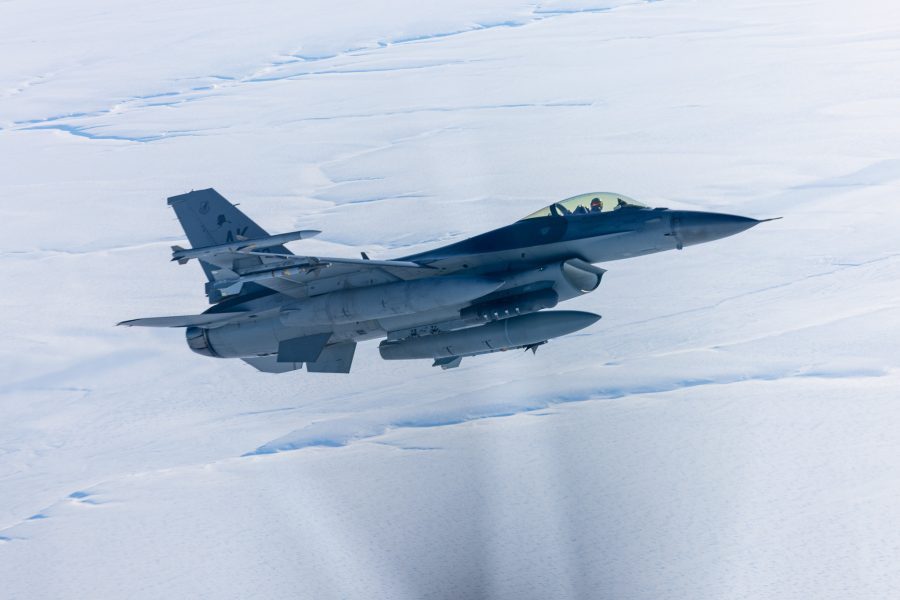U.S. Air Force F-16s intercepted a Russian spy plane operating off the coast of Alaska on consecutive days, North American Aerospace Defense Command officials said.
A Russian Il-20 surveillance aircraft ventured near Alaska Aug. 20, NORAD said in a statement at the time. And roughly 24 hours later, NORAD disclosed that a similar incident occurred the next day on Aug. 21.
The flights come less than a week after President Donald Trump and Russian President Vladimir Putin met at Joint Base Elmendorf-Richardson, Alaska, for a summit to discuss how to end the war in Ukraine. The base houses F-22 Raptors, which are sometimes used to intercept Russian warplanes.
There was no discussion during that summit meeting of the two sides changing their own military postures. And the Russian flights and the U.S. intercepts are hardly unusual.
The Russian Il-20s, known in NATO parlance as the “COOT,” flew in the Alaskan Air Defense Identification Zone—international airspace that extends out from America’s sovereign territory and is used as a buffer for air defense.
On Aug. 20, that prompted NORAD to send American F-16s, along with a KC-135 aerial refueling tanker for support, to “positively identify and monitor the aircraft,” according to a statement from the joint American-Canadian command that is in charge of protecting the countries’ airspace.
The next day, NORAD again sent up two F-16s and a KC-135, this time along with an E-3 Sentry command and control aircraft, to “intercept, visually identify, and monitor the Russian aircraft in the Alaskan ADIZ,” an Aug. 21 statement from the command said.
Yet another Russian Il-20 flight in the Alaskan ADIZ was intercepted Aug. 24, NORAD said, after command responded by launching two F-16s, an E-3, and a KC-135.
While Russian Tu-95 bomber flights near Alaska are fairly common—and have been since the Cold War—the Il-20 is a rarer and more secretive plane outfitted with electronic intelligence-gathering equipment. The Russian Air Force is known to have deployed the plane to Syria when Russian forces were there supporting the now-ousted regime of Bashar al-Assad.
Syrian forces mistakenly shot down an Il-20 in 2018 in an attempt to down Israeli warplanes that were conducting a bombing mission in the country. Since Russia’s full-scale invasion of Ukraine in February 2022, Il-20s have been intercepted numerous times by European air forces while operating in the Baltics.
A large-scale U.S.-Canadian-led naval and air exercise, Northern Edge, is underway around Alaska involving some 6,400 military personnel, 100 aircraft, and seven ships, including the aircraft carrier USS Abraham Lincoln. A NORAD spokesperson did not say whether any vessels had been surveilled.
“The Il-20 flew inside the ADIZ for approximately 1 hour and 12 minutes; the location of the incursion was approximately 25 nautical miles from St. Lawrence Island,” the spokesperson for NORAD told Air & Space Forces Magazine of the Aug. 20 incident. St. Lawrence Island, part of Alaska, is located south of the Bering Strait, less than 50 miles from the Russian Far East.
The Aug. 21 incursion lasted twice as long, over two hours, according to the spokesperson, and occurred some 100 miles from Cape Lisburne, the northernmost point in Alaska.
“The Russian military aircraft remained in international airspace and did not enter American or Canadian sovereign airspace,” NORAD said in a statement.
NORAD declined to say whether the same Russian plane was involved in both incidents.
“Our focus remains on detecting and appropriately responding to aircraft operating in the ADIZ in defense of North America,” the spokesperson said.
U.S. Air Force F-16s are assigned to NORAD at Eielson Air Force Base near Fairbanks, Alaska—the likely launching point for the American aircraft.
While the Alaskan ADIZ has close proximity to Russia, NORAD stated that the airspace requires the “ready identification of all aircraft in the interest of national security,” which prompts multiple intercepts with Russian aircraft a year.
The U.S. military conducts flights in other countries’ declared ADIZ areas, especially around disputed islands in the South China Sea. While China often protests, the U.S. insists it is operating lawfully in international airspace in those cases.
Last month, NORAD intercepted two Russian Tu-95 “Bear” bombers and Su-35 “Flanker” fighter jets that were escorting them when they strayed into the ADIZ for some three hours.
In its statements, NORAD stressed the Il-20 flights are “not seen as a threat.” The flights do, however, come against a backdrop of strained peace efforts between the U.S., Ukraine, and Russia.
On Aug. 21, Trump appeared to implicitly endorse Ukrainian strikes inside of Russia. But the Trump administration has not provided Ukraine with long-range weapons to carry out such attacks.
“It is very hard, if not impossible, to win a war without attacking an invaders country,” Trump wrote on his Truth Social platform. “It’s like a great team in sports that has a fantastic defense, but is not allowed to play offense. There is no chance of winning! It is like that with Ukraine and Russia.”
“Interesting times ahead!!!” Trump concluded.
This article was updated with details of a Russian Il-20 flight in the Alaskan ADIZ Aug. 24.


